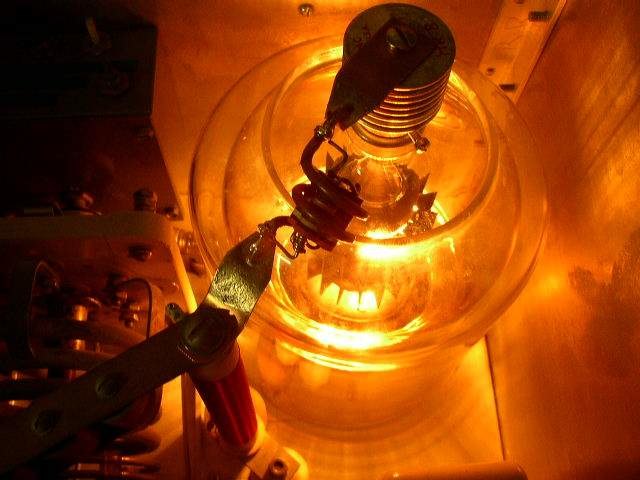Thermionic emission is the liberation of electrons from an electrode by virtue of its temperature. This occurs because the thermal energy given to the charge carrier overcomes the work function of the material. The charge carriers can be electrons or ions, and in older literature are sometimes referred to as thermions. After emission, a charge that is equal in magnitude and opposite in sign to the total charge emitted is initially left behind in the emitting region. But if the emitter is connected to a battery, the charge left behind is neutralized by charge supplied by the battery as the emitted charge carriers move away from the emitter, and finally the emitter will be in the same state as it was before emission.

Closeup of the filament in a low pressure mercury gas-discharge lamp showing white thermionic emission mix coating on the central portion of the coil. Typically made of a mixture of barium, strontium and calcium oxides, the coating is sputtered away through normal use, eventually resulting in lamp failure.
One of the bulbs with which Edison discovered thermionic emission. It consists of an evacuated glass light bulb containing a carbon filament (hairpin shape), with an additional metal plate attached to wires emerging from the base. Electrons released by the filament were attracted to the plate when it had a positive voltage.
Schottky-emitter electron source of an electron microscope
In vacuum tubes and gas-filled tubes, a hot cathode or thermionic cathode is a cathode electrode which is heated to make it emit electrons due to thermionic emission. This is in contrast to a cold cathode, which does not have a heating element. The heating element is usually an electrical filament heated by a separate electric current passing through it. Hot cathodes typically achieve much higher power density than cold cathodes, emitting significantly more electrons from the same surface area. Cold cathodes rely on field electron emission or secondary electron emission from positive ion bombardment, and do not require heating. There are two types of hot cathode. In a directly heated cathode, the filament is the cathode and emits the electrons. In an indirectly heated cathode, the filament or heater heats a separate metal cathode electrode which emits the electrons.

A tungsten filament acting as a directly heated cathode in a low pressure mercury gas discharge lamp which emits electrons. To increase electron emission, a white thermionic emission mix coating is applied on hot cathodes, visible on the central portion of the coil. Typically made of a mixture of barium, strontium, and calcium oxides, the coating is sputtered away through normal use, eventually resulting in lamp failure.
Two indirectly heated cathodes (orange heater strip) in ECC83 dual triode tube
Glow of a directly heated cathode in an Eimac 4-1000A 1 kW power tetrode tube in a radio transmitter. Directly heated cathodes operate at higher temperatures and produce a brighter glow. The cathode is behind the other tube elements and not directly visible.
SEM Image of G1 Support and G1 Wire, of a heavily used Pentode showing Barium oxide Contamination (green) from the cathode.






